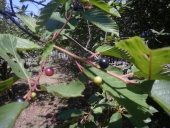
 1
1




Freakin' hippies and Squares, since 1986
 1
1




 1
1




Freakin' hippies and Squares, since 1986
 1
1




Landon Sunrich wrote:
Edit: Just making sure we're on the same page
http://en.wikipedia.org/wiki/Hippophae
Seaberry?
 3
3




Trying to achieve self-reliance on a tiny suburban plot: http://gardenofgaladriel.blogspot.com
 2
2








- Grapes
- Huckleberries
- Rhubarb
- Blackcurrant
- Almond (newly planted, though)
- Daylily
- Apple
- Cherry
- Plum
- Pear
- Asparagus
- Nasturtium (an annual, but self seeds here like nobody's business!)
- Lots of herbs, such as rosemary, mint, oregano, etc
- Strawberry
- Plums
- Raspberries (the native blackcaps have the best flavor)
- Blueberries
- Certain varieties of apple
- Blackberries and most other berry vines
- Hazelnuts (AKA filberts)
- Seaberries
- Stinging nettle (native)

 1
1




Paul Cereghino- Ecosystem Guild
Maritime Temperate Coniferous Rainforest - Mild Wet Winter, Dry Summer





Ask me about food.
How Permies.com Works (lots of useful links)





Julia Winter wrote:I just moved to Cully, Portland, and I haven't seen any lambs quarters. Anybody in Portland have a good recurring patch? (They are annual, but self seed readily. I used to eat a lot of lambs quarters in Wisconsin--I like them as much as spinach and they take care of themselves!
Freakin' hippies and Squares, since 1986




Freakin' hippies and Squares, since 1986




Unlike many medicinal plants, which have a long history of uses, foxglove (Digitalis purpurea) was not an important medicine until the late 18th century. In 1776, William Withering was a physician with a large country practice in England. A lady was dying from a disease called dropsy, or edema, in which liquids accumulate in the body and cause swelling of tissues and body cavities. He left her, expecting her to die shortly, but he later learned that she had recovered after taking an old cure of a garden plant called foxglove. For ten years, Withering conducted experiments to demonstrate the uses of foxglove and discovered that dropsy is actually a symptom of heart disease in which the heart does not pump hard enough to get rid of urine. He showed that foxglove stimulated urination by pumping more liquids to the kidneys. Withering died before his results appeared in print, so he never got to see how foxglove, or digitalis, became a lifesaver for heart disease patients. Digitalis is very toxic and fatal with an overdose, so its potency was measured very carefully. Digoxin presumably binds to the membranes of the muscle cells and aids in the pumping of sodium and potassium ions. This then slows heart rate and also reduces heart size, which lessens myocardial oxygen demand.
 1
1




"In a fruit forest everyone is happy"- Sepp Holzer
 5
5




Butch Trail
www.NorthwestOlla.com
Clay Pot Irrigation




Charles Tarnard wrote:In addition to the list above, I have a number of neighbors with GIGANTIC grape vines running all over their place producing fruit like nobody's business. My grapes are too young to tell you my experience with them, but I expect good things if I can get them to survive this damn freezing rain.
A few years ago I planted 6 shrubs under a spruce tree. 2 wintergreen, 2 lingonberry and 2 huckleberry. I didn't really water them properly and they had no sunshine, but in spite of that one huckleberry still lives. It hasn't really produced yet, but it's pretty damn hardy.




Jesus Martinez wrote:
Charles Tarnard wrote:In addition to the list above, I have a number of neighbors with GIGANTIC grape vines running all over their place producing fruit like nobody's business. My grapes are too young to tell you my experience with them, but I expect good things if I can get them to survive this damn freezing rain.
A few years ago I planted 6 shrubs under a spruce tree. 2 wintergreen, 2 lingonberry and 2 huckleberry. I didn't really water them properly and they had no sunshine, but in spite of that one huckleberry still lives. It hasn't really produced yet, but it's pretty damn hardy.
Huckleberries will really only produce a decent crop when they can get sun. In full shade, their yield will be much much lower.
 .
. 



Freakin' hippies and Squares, since 1986
 3
3




 1
1




www.alwaysgrowingdesign.weebly.com
"It is, of course, one of the miracles of science that the germs that used to be in our food have been replaced by poisons." - Wendell Berry




 2
2




Landon Sunrich wrote:I'm wondering what everyone's favorite perennials are for the pacific northwest. I have extensive experience cultivating annuals around here - but not to much with perennials. Of course I'm looking for the perfect plants. Ones that produce lots of food reliably and don't take much care. What are your favorite perennials to use here in the PNW
 2
2








Rick Valley at Julie's Farm

|
These aren't just sunglasses. They are a coolness prosthetic. For this tiny ad:
The new permaculture playing cards kickstarter is now live!
https://www.kickstarter.com/projects/paulwheaton/garden-cards
|





